As I write, the valley is unified by a deep freeze. Deep enough for the ground not to give underfoot and for the first time this winter an icy lens is thrown over the pond to blur its reflection. The farmers use this weather to tractor where they haven’t been able to for the mud. The thwack of post drivers echoes where repairs need to be made to the fences and slurry is spread on the fields that have for a while been inaccessible. It you are lucky, this is exactly the weather when you might get your manure delivery.
I welcome the freeze in the garden, for the last few weeks have been uncannily mild. Warm enough to push an occasional primrose and a smatter of violets. This year we have early hellebores, rising already from their basal rosettes and reminding me to cut away last year’s foliage so that the flowering stems can make a clean ascent. Good practice says to remove the leaves in December to diminish the risk of hellebore leaf spot. So far, whilst I have been nurturing young plants, I prefer to see the flowers pushing before I cut and know that the leaves have done all they can to charge the display.

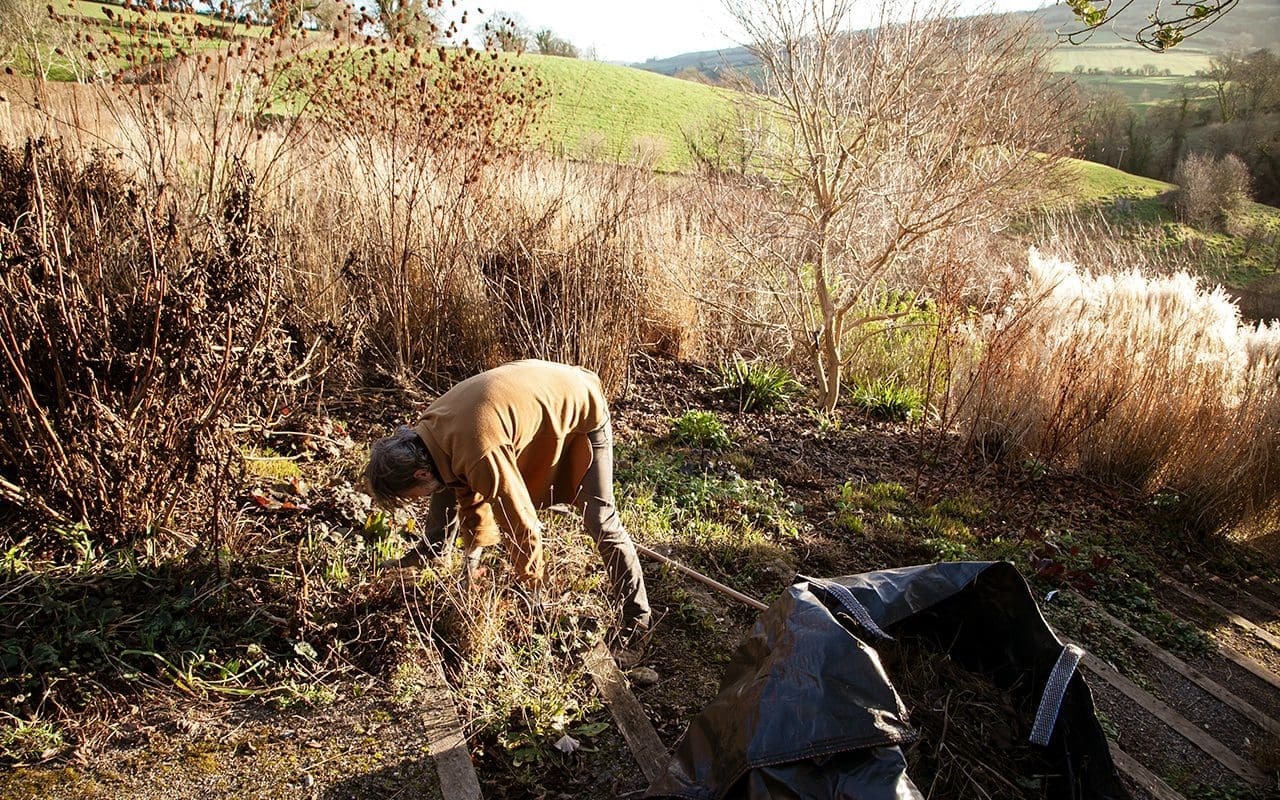
As the garden matures it is already leaning on me to step in line where in its infancy I retained the upper hand in terms of control. I chose to wait until the end of February before doing the big cut back all in one go to allow as much as possible to run through the season without disturbance. Not so just five years on. I need to start engaging if I am not to make things more and not less labour intensive. It is all my own doing of course, because the more I add to the complexity of the garden, the earlier we have to start to be ready for spring. Where I have planted bulbs amongst the perennials for instance, the bulbs demand that I ready these areas to avoid snubbing their noses.
In terms of letting things be and allowing the garden to find its own balance, I want there to be a push and a pull between what really needs doing and where the natural processes can help me to tend the garden. The fallen leaf litter is already providing the mulch I need to protect the ground under the young trees, so it is in these areas I am concentrating the plants that need early attention. The hellebores and their associated bulbs can now push through the leaf litter. I no longer have need to mulch in these areas and save the annual trim to the hellebores and the shimmery Melica altissima ‘Alba’, the balance here is successfully struck.
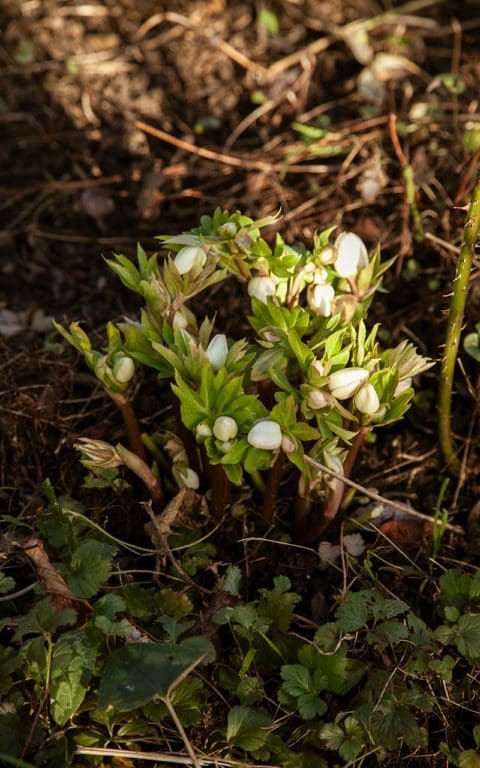
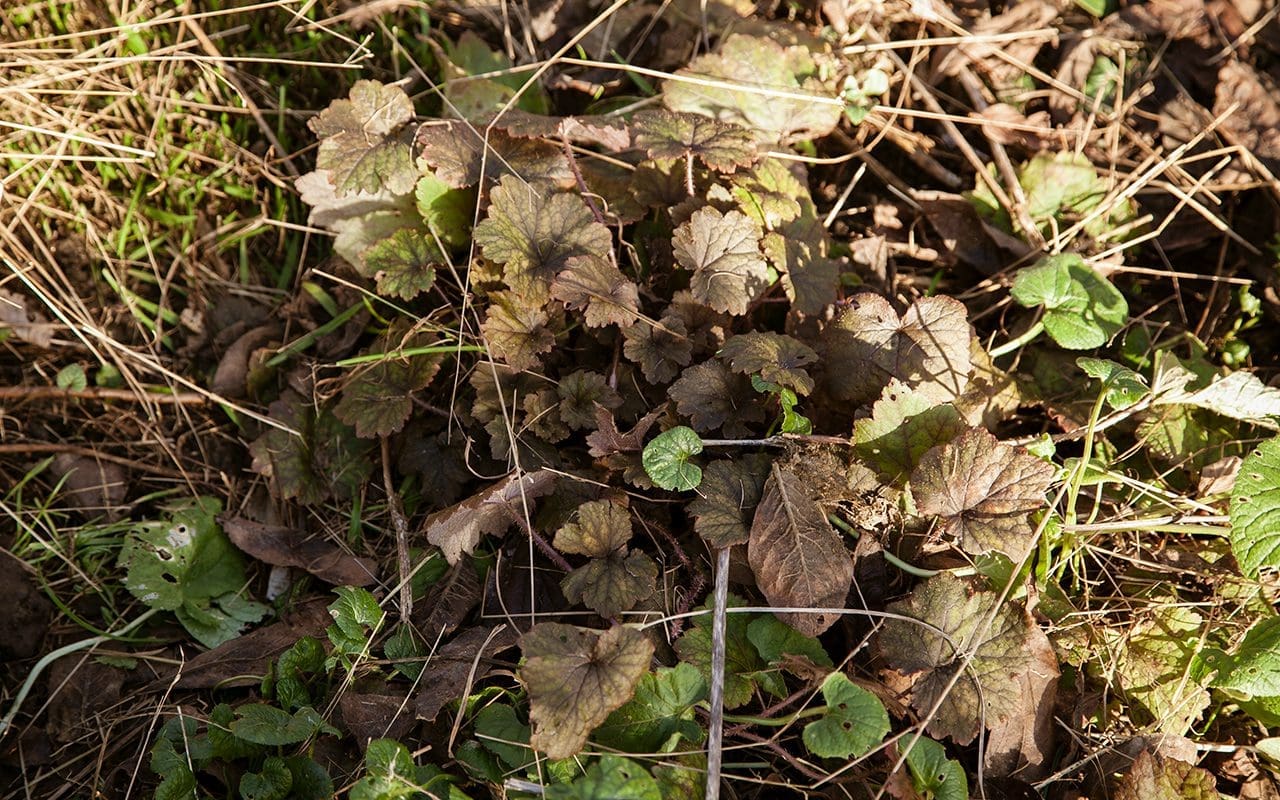
We try to get our winter work, which tends to be bigger scale and mostly beyond the garden, all but done by the end of February. Our own fence and hedge work, tree planting and pruning. The ‘light touch’ beyond the garden will see us strim the length of the ditch before the snowdrops come up, but leave it standing for as long as possible where there are no bulbs. We come back on ourselves before the primroses start. Being further down the slope and colder, growth is later there, but the end of February date works. We leave the coppice beyond the ditch untouched, hitting the brambles every three or four years to curb their domain, because the coppice also needs time to establish without competition. Beyond that, and in the areas where we are letting the banks completely rewild, we watch the brambles spread and note how quickly the oaks that have been planted by the jays and squirrels, spring up amongst them. One day the shadow will put pressure on the brambles, which will fall in line and not be the dominating force. Watching what happens and applying your energies only to what is needed is a good reminder for what one should be doing as a gardener back in the cultivated domain.
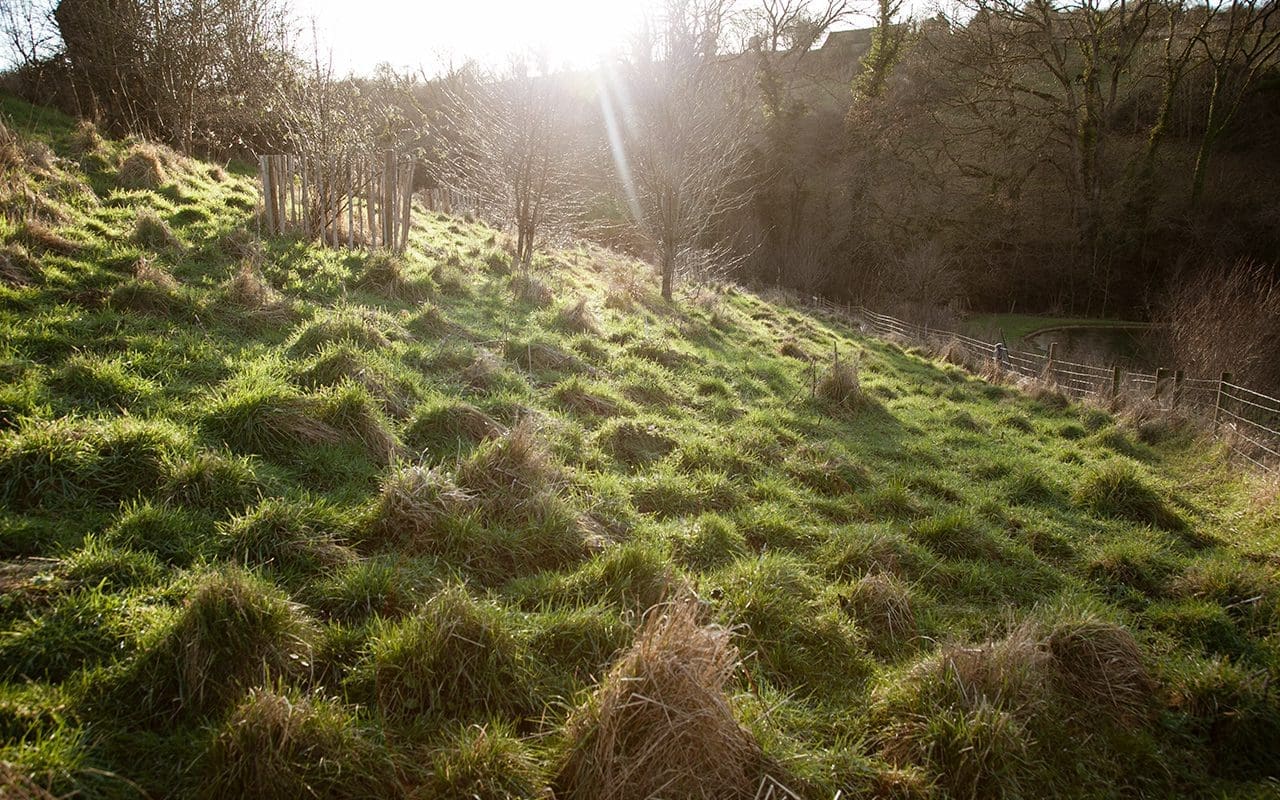
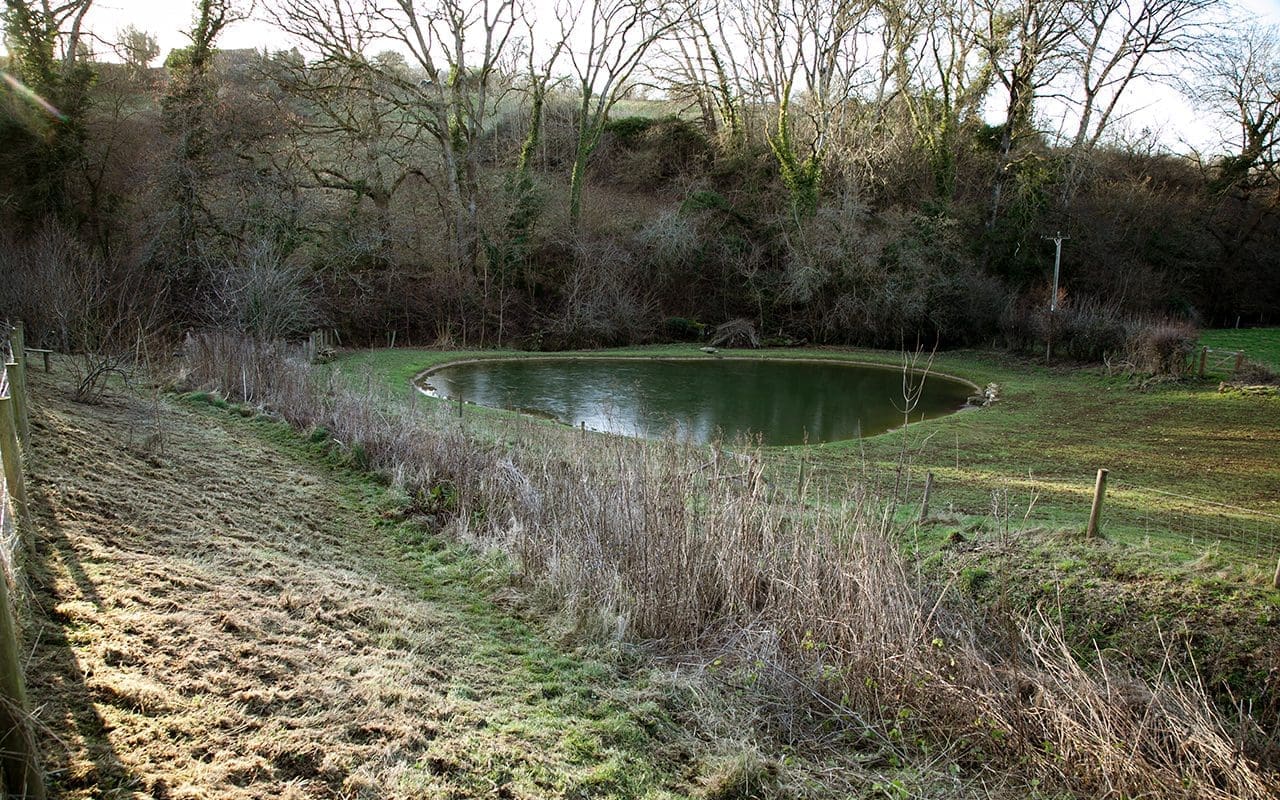
The tussocky slopes that are too steep to cut on the hay meadows are a beautiful thing. They are very different as a habitat from the machine-managed sward that is kept in check by the hay cut, the grazing and the associated yellow rattle, which will only grow there where it is not outcompeted. The contrast of the tussocky land nearby with its peaks and troughs created by the grazing animals and not a combine provide a place where the rodents live and in turn where the owls and raptors come to feed. In summer you can look into these miniature landscapes and see the other world they offer for yourself. The cool side of a tussock and the warm side where the butterflies bask and the different webs or spiders that take advantage of the peaks and hollows of the undisturbed ground. From our own perspective as custodians and drivers of what happens here, the tussocky ground is a beautiful reminder. Catching the low winter light, its contours draw you to remember that it is good to touch down lightly where you can afford to and only apply your energies at the right time and in the right place.
Words: Dan Pearson | Photographs: Huw Morgan
Published 22 January 2022
Cultivated in England since the early part of the 16th century, the black mulberry is a tree that has a timeless quality. A ruggedness that speaks of previous custodians, of care and cultivation and lives lived around it. A mature tree, squat and always rounded, shows the decades in its fissured bark and the mosses and lichens that find a home there on twisting limbs. Limbs that often reach to the ground under their own weight and lean on elbows to root where they have rested. If you step inside the cradle of branches you find a leafy world within, the lush foliage hiding bloody fruits, like sharp, juicy loganberries, that stain your hands and mark your appetite in August.
As Morus nigra have been widely cultivated for so long, it is not known from where exactly they originated. Mesopotamia and Persia are listed when you try to understand their requirements and, though vague, this does explain their desire for a warm position and their preference for southern England. As temperatures warm their range will surely extend slowly north so they may well become more widespread as vineyards move up the country. They are often grown in association in Persia since the conditions vines favour are typical of their preferred habitat. Warm slopes and free drainage. Somewhere that basks in sunshine.
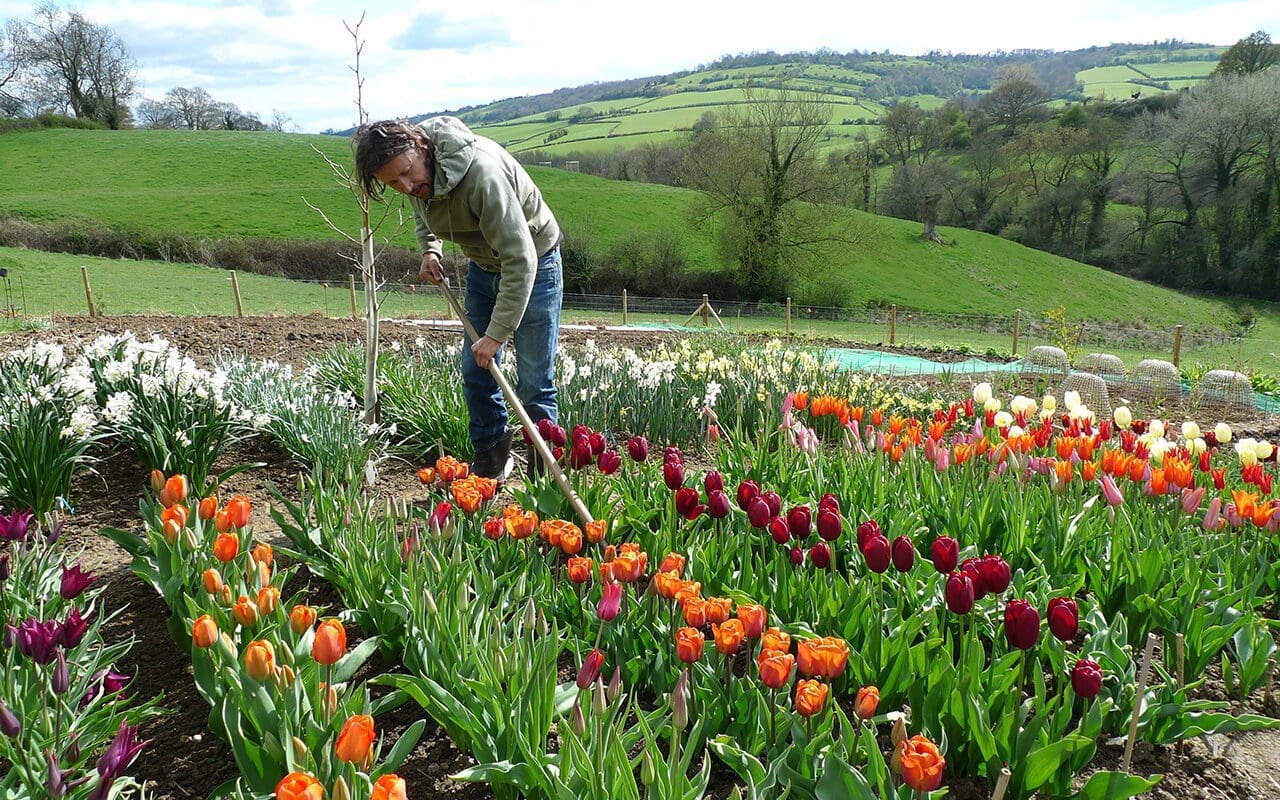
Morus nigra was mistakenly introduced into this country in the belief that it was the fodder for silkworms. The white mulberry (Morus alba) – the real food crop of the silkworm and a bigger tree – has inferior fruit and less charisma in a garden. However, you will often be sold it as a substitute since they are more easily grown in the field. Black mulberries are rarely sold as large plants and are most often containerised and supplied as feathered maidens of not more than 1.5m. That said, they are not as slow as you might imagine and begin to show character remarkably early in life.
Our mulberry was one of the first trees I planted in our first winter here in 2011. Though I only had the garden in my mind’s eye at that point, I placed a young maiden in the rectangle the farmer before us had carved out of the field to grow his brassicas. Now that I know the land better and the winds that race down the valley, I see why he had put his only growing patch just here. It has the hedge behind it and the shelter of the house not so far away. Despite the fact that there were no trees here initially, I instinctively knew that a mulberry would be my gateway tree to the garden that one day would follow. A tree that would eventually hug the hill and make this place into a garden as it matured and brought with it that certain gravity.
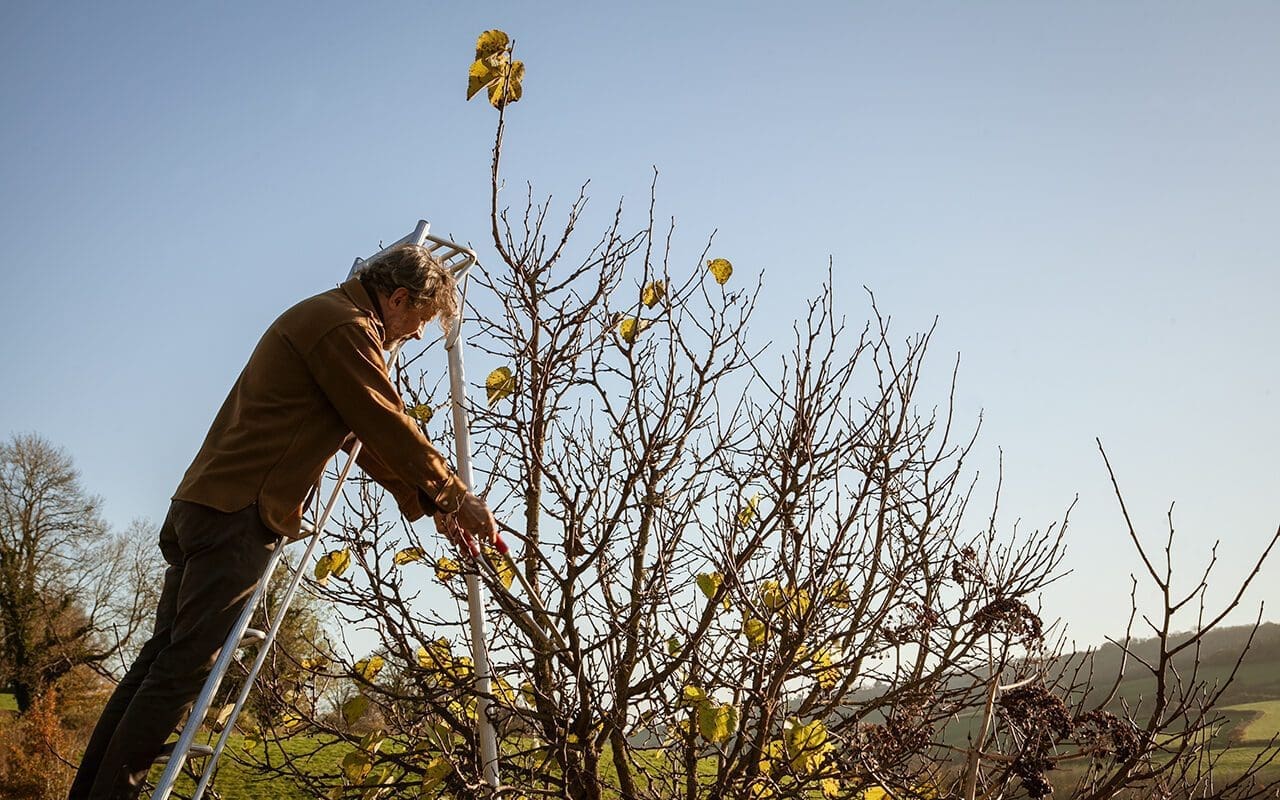
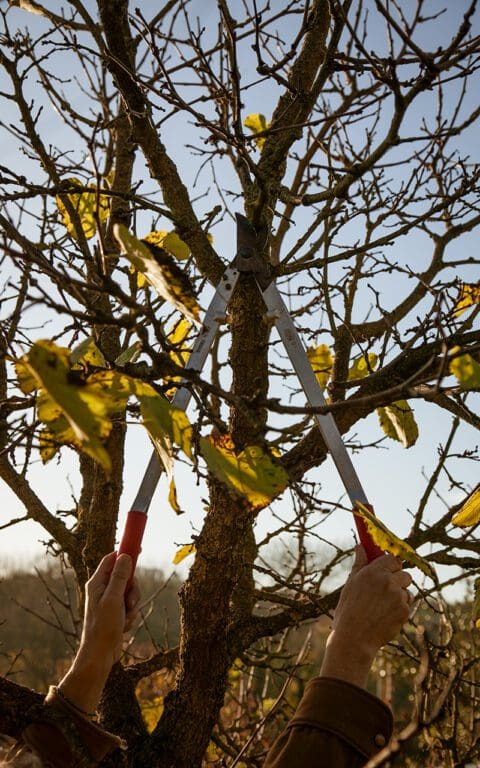
Planting trees early in a project is a rewarding milestone with time mapped in new branches. My youngster, with all its promise, sat amongst the rotations of our temporary vegetable and perennial trial garden for the following five years. Every year gathering a little more strength and presence and slowly making us work further around it to ensure its well-being. By the time I finally made the garden in the summer of 2016, it was already the deciding factor for where the paths would sit to either side. One grass path to the rear and the other – the primary route into the garden – on the sunny side. Ten years in, and with the garden now grown around it, the tree has already formed its own microclimate, a pool of shade beneath, where pulmonarias and snowdrops trigger spring and a place on the grassy walk behind where the grass is cool and shady on a summer’s day. Together with the medlar which is planted nearby, it already gives this young garden a feeling of age and establishment.
Though in time I know my tree will become idiosyncratic, with limbs and character that I could never plan for, I like to set a young tree in the right direction with formative pruning to establish a good framework. In the case of the mulberry, the structuring of the tree is also to keep it open with free air movement, because in the last couple of years we have slowly seen mulberry leaf spot wither the lush foliage in high summer.
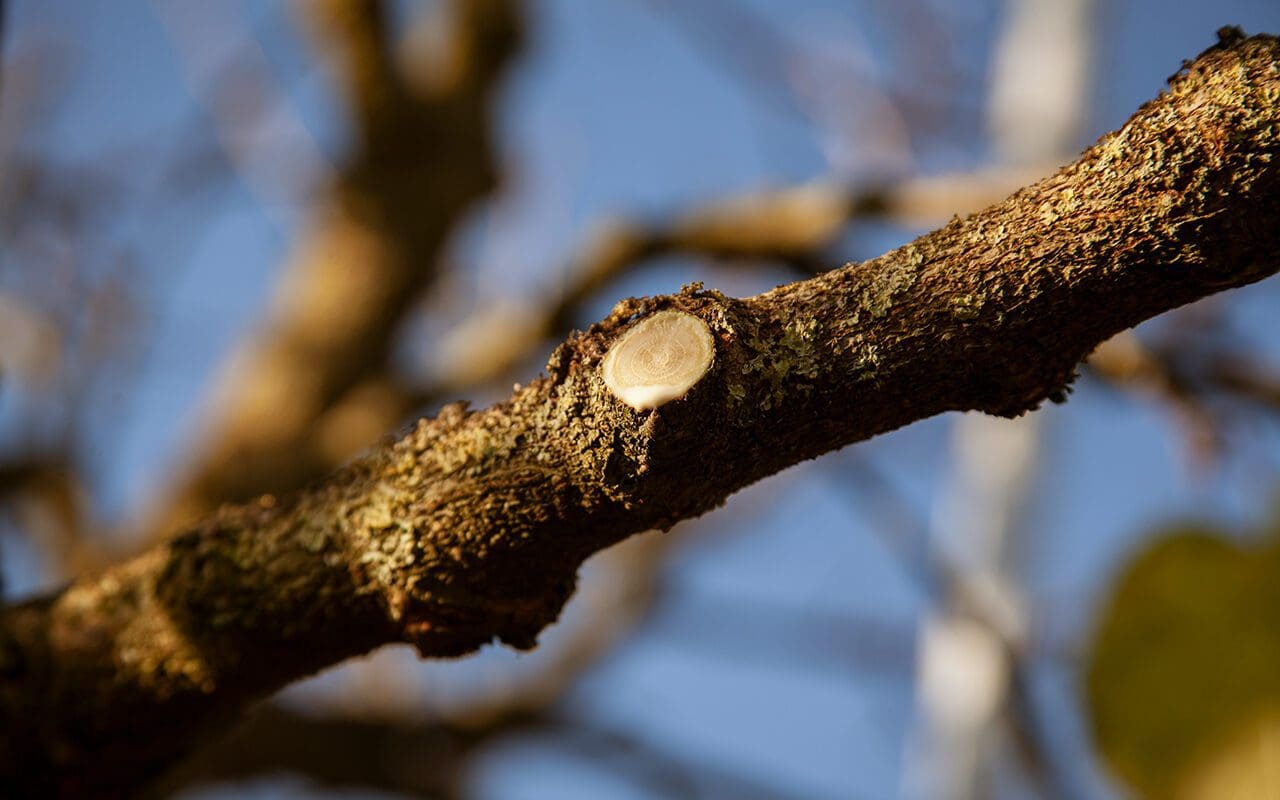


Leaf spot, a fungal infection caused by either Cercospora moricola or Phloeospora maculans, is quite common on mulberries. It is noted that the fungus is most prevalent in wet conditions, and recent outbreaks in Turkish orchards have followed mild, wet winters, so we avoid watering near the tree on the rare occasions I put out the oscillator. This year we also applied a neem oil spray every fortnight as soon as the tree broke bud, which had a noticeably positive impact. Of course, come a busy August, there wasn’t time to be consistent, and so spraying stopped, but the tree has done better for it, only showing signs of infection again in September. We have cleared the fallen foliage to remove the spores that fall with the foliage and hope as time goes on that it will be only be a problem in wet summers.
Mulberries bleed to their detriment if you prune in the second half of the winter, so I do this in late autumn as the leaves drop and the sap is being drawn back. It is an easy and meditative process and I remove a small amount only, to thin the limbs and not trigger sappy regrowth. The time spent with the tree allows me the opportunity to imagine the branches reaching out and over the paths one day. An easy reach for a luscious berry as we enter and exit the garden and take pleasure in the knowledge that with time this tree will only get better.
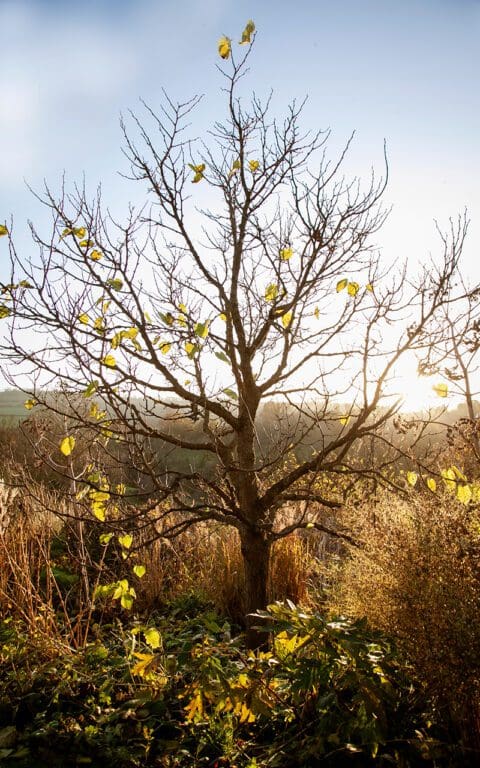
Words: Dan Pearson | Photographs: Huw Morgan
Published 27 November 2021
A chill easterly wind has held us firmly in its grip, whistling around the house and freezing the puddles and the muddy gateways. The pots of early bulbs have frozen solid even up by the house, their growth suspended for now. I look out over a landscape that feels right for February. A crunch underfoot and the mixed feeling of knowing this is as it should be, but hoping that the bay tree will survive the scorch it has suffered from being left to fend for itself in previous years. Wrapped in advance of the freeze last week, I’m feeling hopeful.
This is our last week of winter work. I drew up a list in late November that we started as soon as the foliage was down on the trees. Weekly tasks beyond the garden that take us out into the rougher places where energies are only applied when the garden itself is resting.
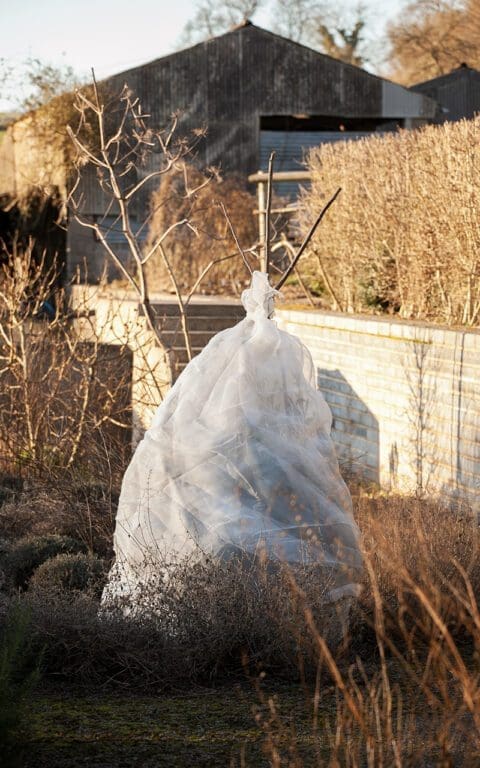
Ten years on and we have begun thinning in the blossom wood to allow the young saplings there the room to become trees. The fast growing hawthorn and Cornus stolonifera, have served their purpose as nurse trees. The microclimate they have provided for the slower growing oaks and Sorbus torminalis has allowed for the canopies to meet and the ground to be protected. Returning there in this period of dormancy we spend a couple of days making gentle clearances. Felled wood is pulled out and logged and the brash is made into brush piles where it slowly moulders back to earth whilst providing shelter for the critters. After snow you can see their footprints going back and forth from these protected places so that we now feel like intruders in the wood. We will revisit for the blossom, but as soon as the nettles that have claimed the open ground have sprung we will leave this place in peace for the summer.
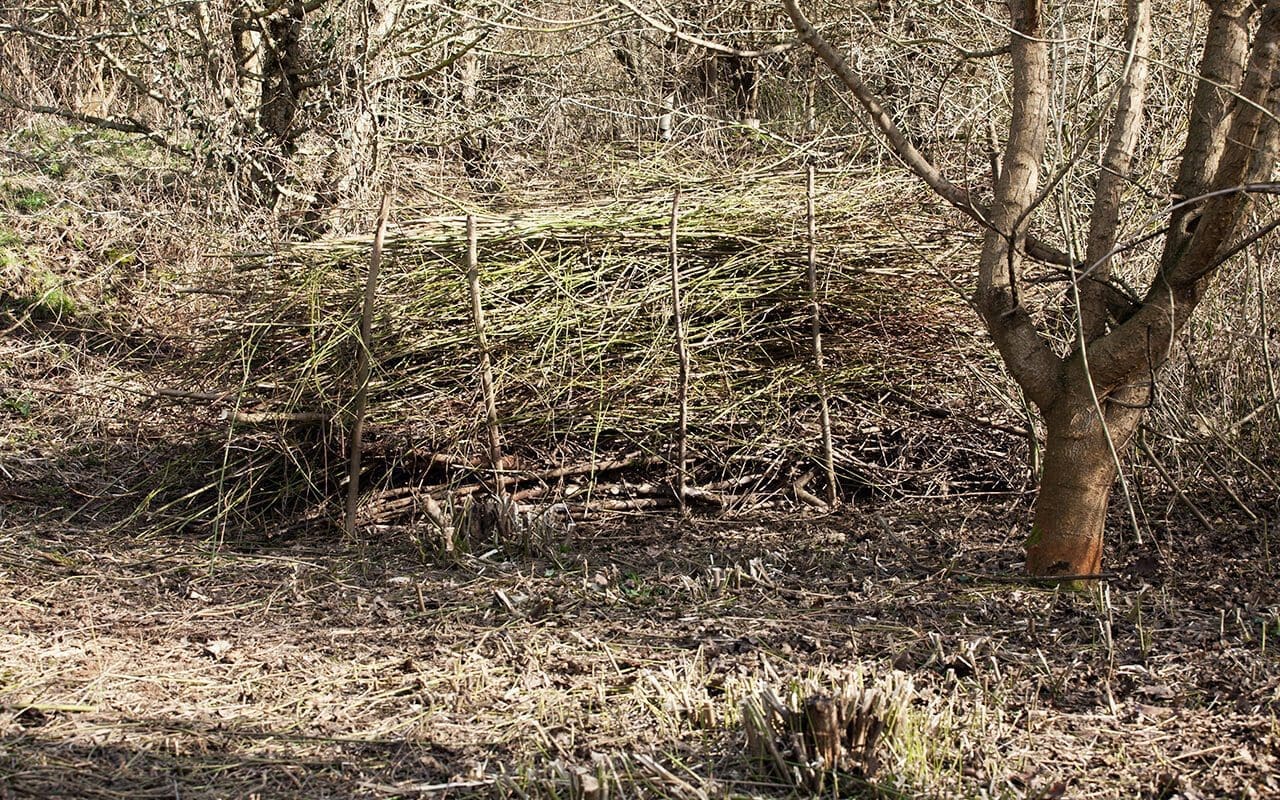
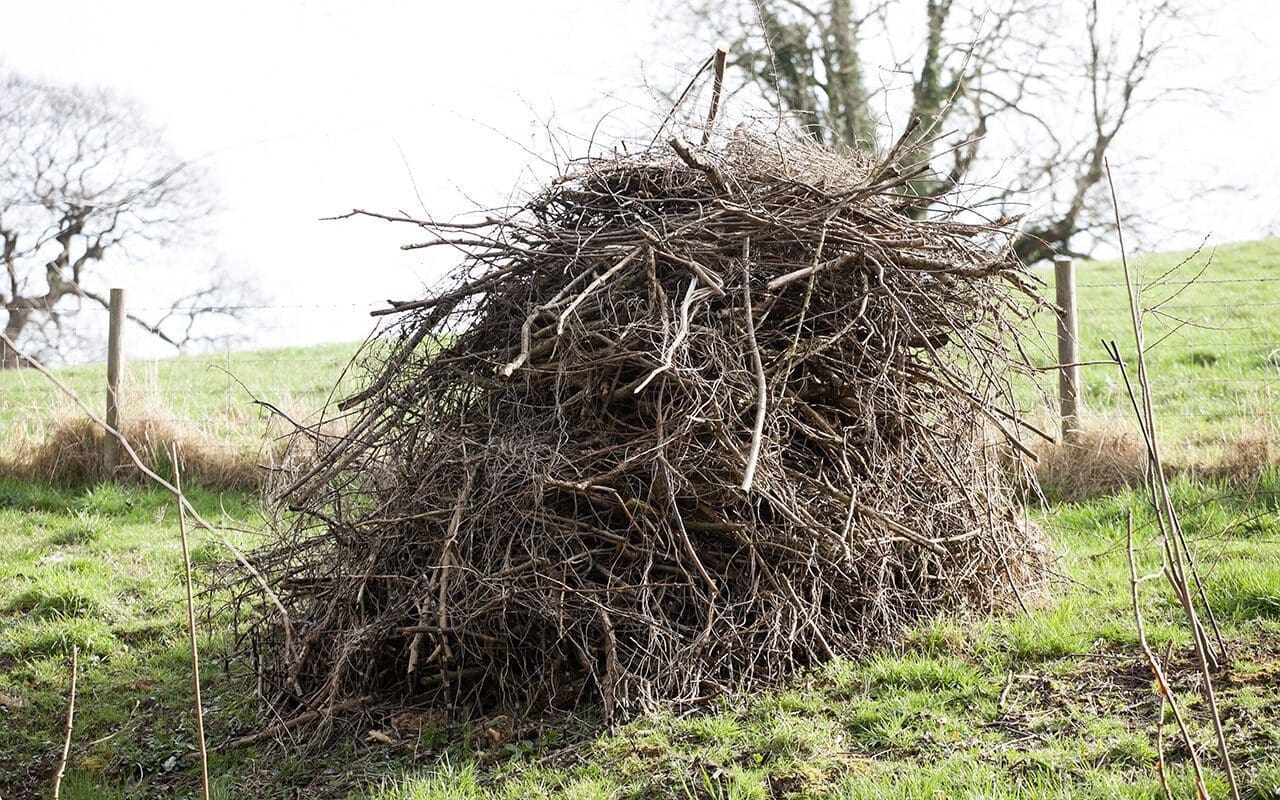
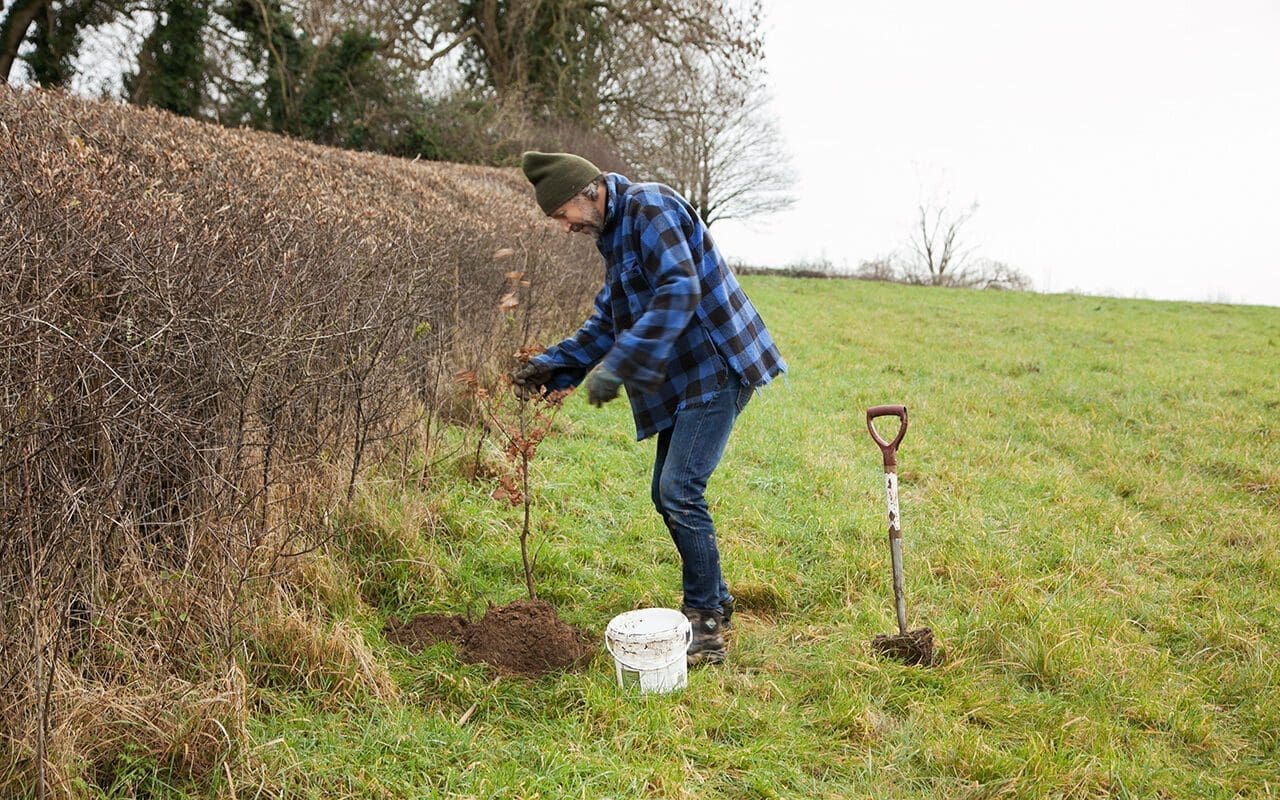
Every year I make it my mission to return trees to the land. At first it was to complement the ash, which is our dominant tree, but now it is to replace them as we are beginning to see the brutal effects of the Ash Die Back that is sweeping the country. To keep the fields that we are retaining for meadow open, new trees have been worked into gaps in the hedges – English lime and field maple – whilst oaks are placed by the gates as marker trees. This year we planted thirty oaks along an open stretch of hedge to extend the still air that is usually harboured to one side of the hedge and provides a hunting grounds for owls and bats. The higher canopy will eventually harbour an invisible highway of stillness that extends their territory and also a future roost for the birds that currently pass through the open landscape. Though we will never see the trees mature, it is a fine feeling to imagine these places and to help begin their futures.
Working slowly inwards, the winter works this year have included the restoration of a hedge below the milking barn that was mostly taken over by elder. The elder is the bully in a hedge, growing faster and muscling out its neighbours, so the plan has not been to eliminate the elder but diminish its numbers where it has become dominant. Three years ago, in preparation for this moment, I sowed hawthorn and guelder rose, wild privet, eglantine rose and spindle from our own saved seed. These youngsters are now ready to be planted, so the old hedge was felled to the base to allow us the chance to pull out the farm detritus that was put there to gap up the holes. Old bedsteads, buckled railings and a chain harrow in this instance. The elder roots will be grubbed out and the remaining hawthorn allowed to re-shoot. We stacked the prunings as a dead hedge to one side where it will be allowed to rot and in the meantime protect the young hedglings that plug the gaps. A new stock-proof fence to the open side will keep them secure until they are grown and established.
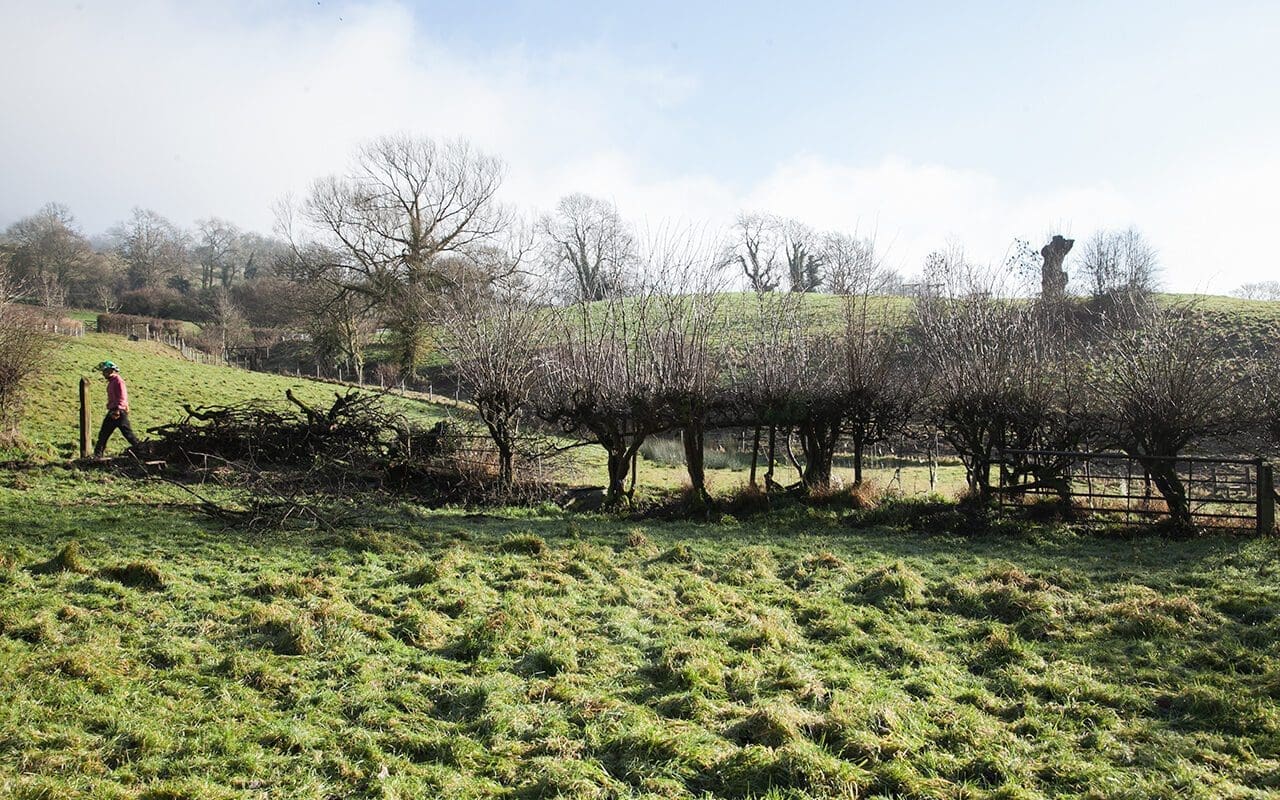
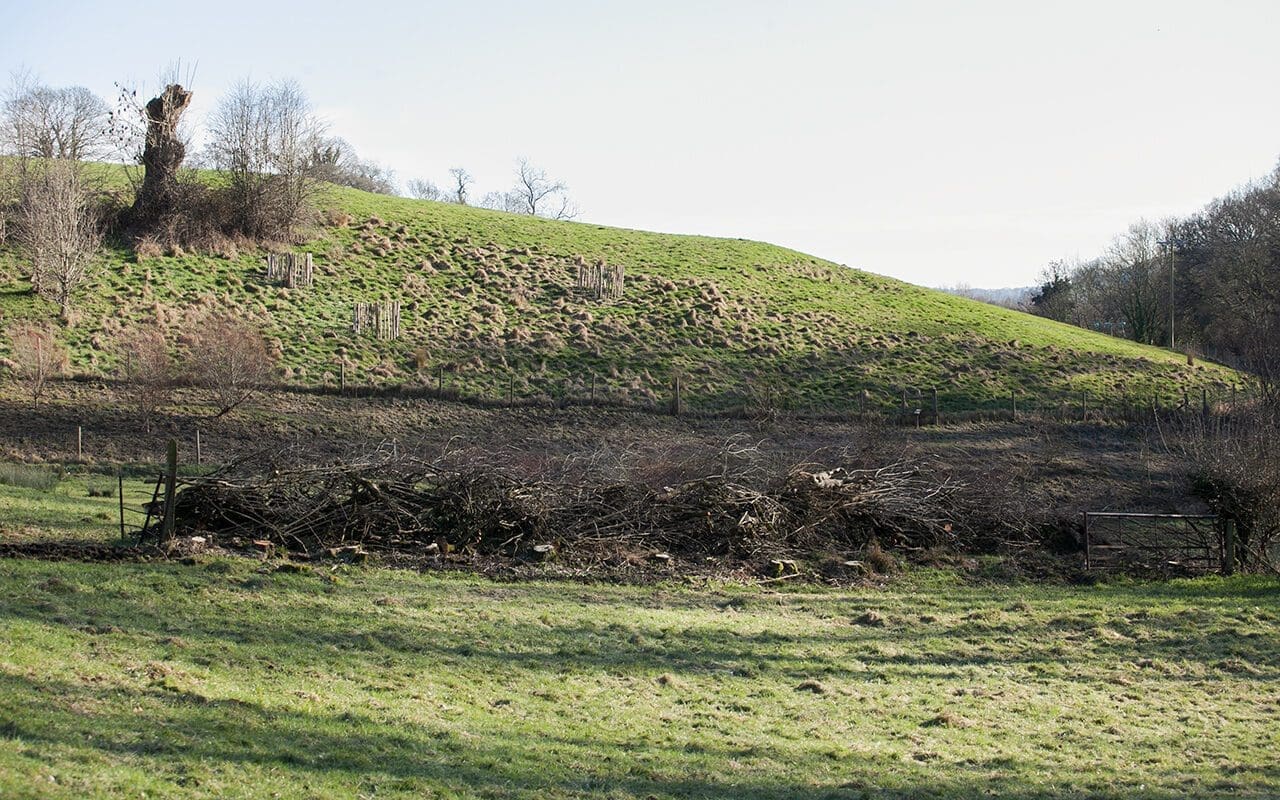
With time finally playing into our hands through not splitting our life with London, the orchard was pruned for the first time properly. I had always intended the trees to be grown to full size and not pruned for production, but we still need to plan for health and good structure. Any diseased wood was taken away first, some trees being more prone to canker than others. Crossing branches were targeted next and then the centre of the trees gently opened to allow free air movement. My grandfather said to maintain their health you should be able to throw your cap through an apple tree. Our trees will be more relaxed than this, but it is good to see, now that they are a decade old, the varieties each assuming their own character. You only know this from growing something for yourself and the thought often has me pondering that you really need another lifetime of learning.
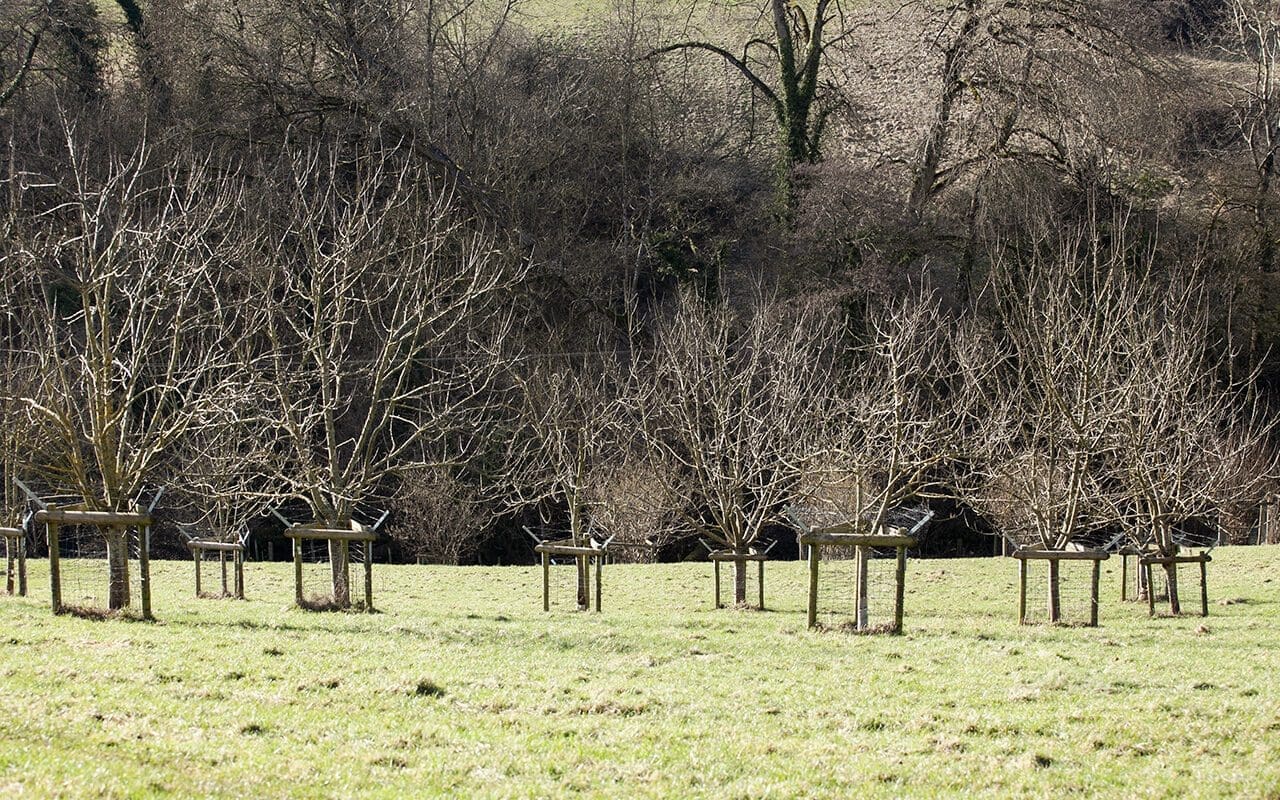
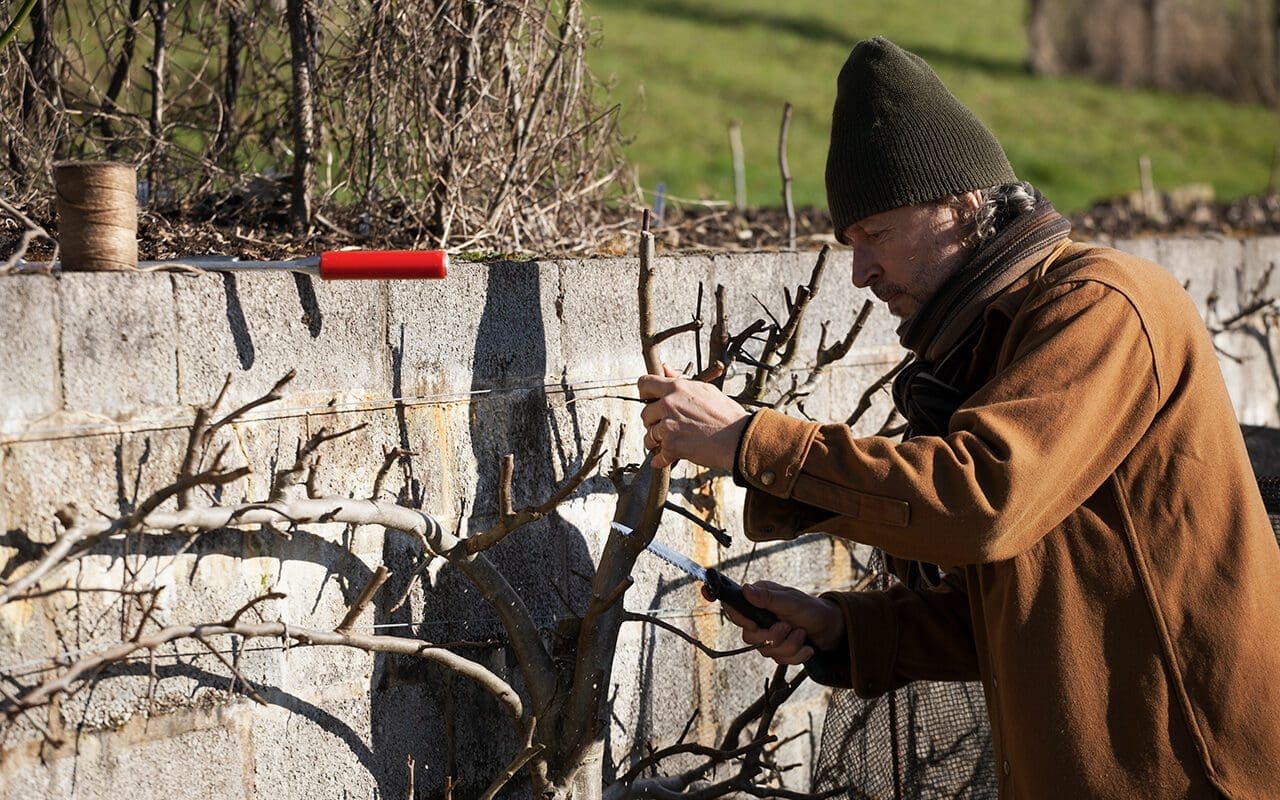
This winter I’ve also had time to revisit the espaliered pears, which are now showing me where I have been too busy to make the right moves in training the limbs in past summers. On one such example, I had to make do with limbs trained from a lower tier where I had simply missed the boat because I was travelling too much for work. You need to plan ahead with trained fruit as the years become mapped in the limbs. A restoration prune, to remove some wood to promote the growth where I need it, should hopefully address time lived too fast and be more worthy of my Wisley training. A gardener’s training that has made me feel a little guilty every time I see my neglect advertised by the poorly trained branches.
Onward, in readiness for beginning the big cut back in the garden next week, we are clearing the compost heap as the final job on the winter works list. The clearances from last year are now composted and good for mulching and soil improvement. One cycle completed, the profits from the last one in barrows full of goodness and the next about to begin.
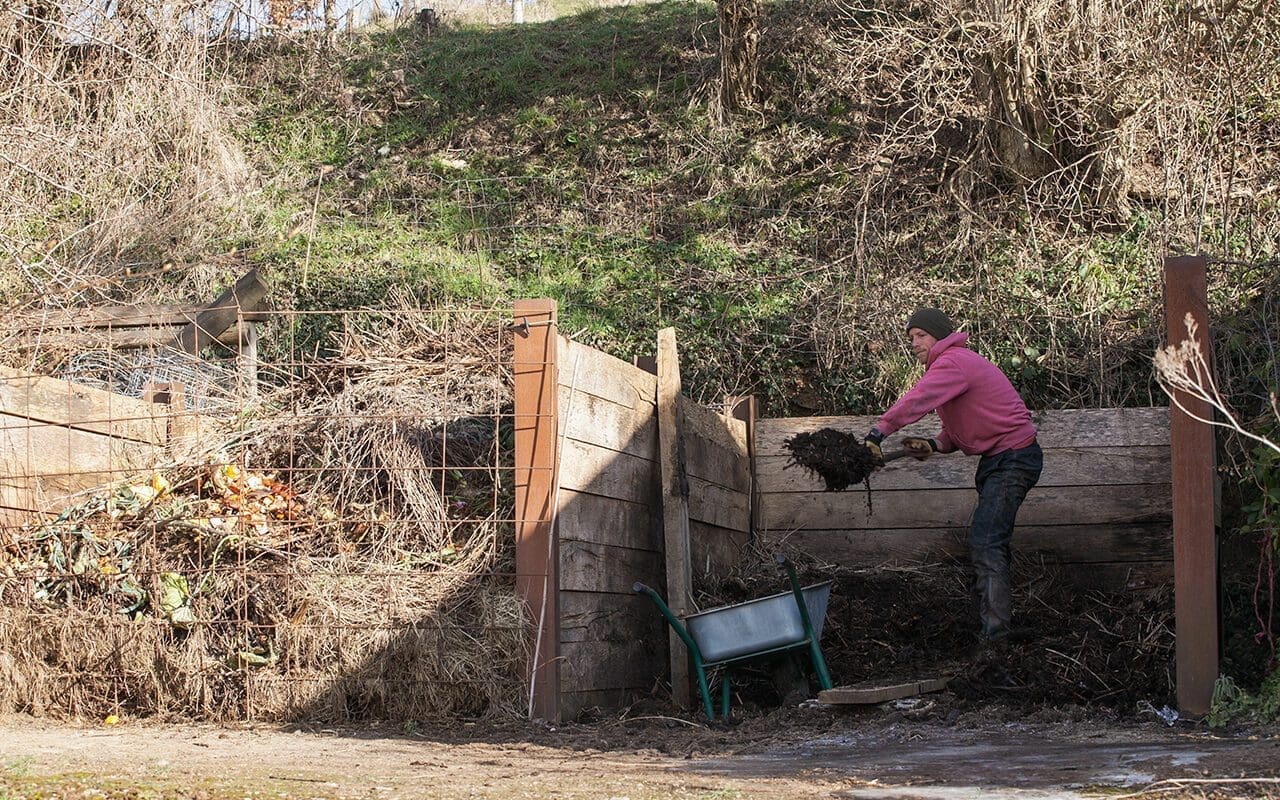
Words: Dan Pearson | Photographs: Huw Morgan
Published 13 February 2021
A stillness descends on the garden in January. Greenery pulled back to resting buds and all that is necessary to sustain the winter. It used to be that I wanted these weeks to be short, to be reunited with growth again, but increasingly this time feels precious for the opportunity to look at the bones. Quietened and slowed by the season and with all laid bare to see.
The weeks ahead are rarely a downtime and we are seldom plunged into a winter that makes the garden unworkable. Our snow lasts for no more than a few days and frost rarely stays in the ground for long. Winter here is a time for doing, readying and making changes. To be lost in actions and practicalities, with a mind’s eye on the spring. At least, this is how I see it and, at the beginning of January, I make a list of winter work that will take us through to the middle of February. The moment the snowdrops are in full swing, letting me know that the garden will also be stirring. In time to be ready to wade into the beds to remove the remains of the last season and free the resting buds to the air and the lengthening days.
The winter tasks begin with pruning and initiating order now that the leaves are down. When I started my formal training in the 1980’s we began the pruning at leaf drop, to work on the hardiest woodies first and to save the least hardy until the tail end of winter. So apples and pears and wall-trained fruits and climbers were the first point of focus. We paced ourselves and worked towards the roses, leaving them until the end of February to avoid making cuts that could then be burned by a freeze. I remember the winters then being harder and rose wood blackened from cuts made too early, but I have brought this work forward here in Somerset. In the ten years we have been here, we have never had a winter that has damaged the wood and the time I make up early in the year allows time for detailed work before winter tips in to spring. Mulching the parts of the gardens where there are bulbs that are yet to push through and splitting the perennials that stir early in March.
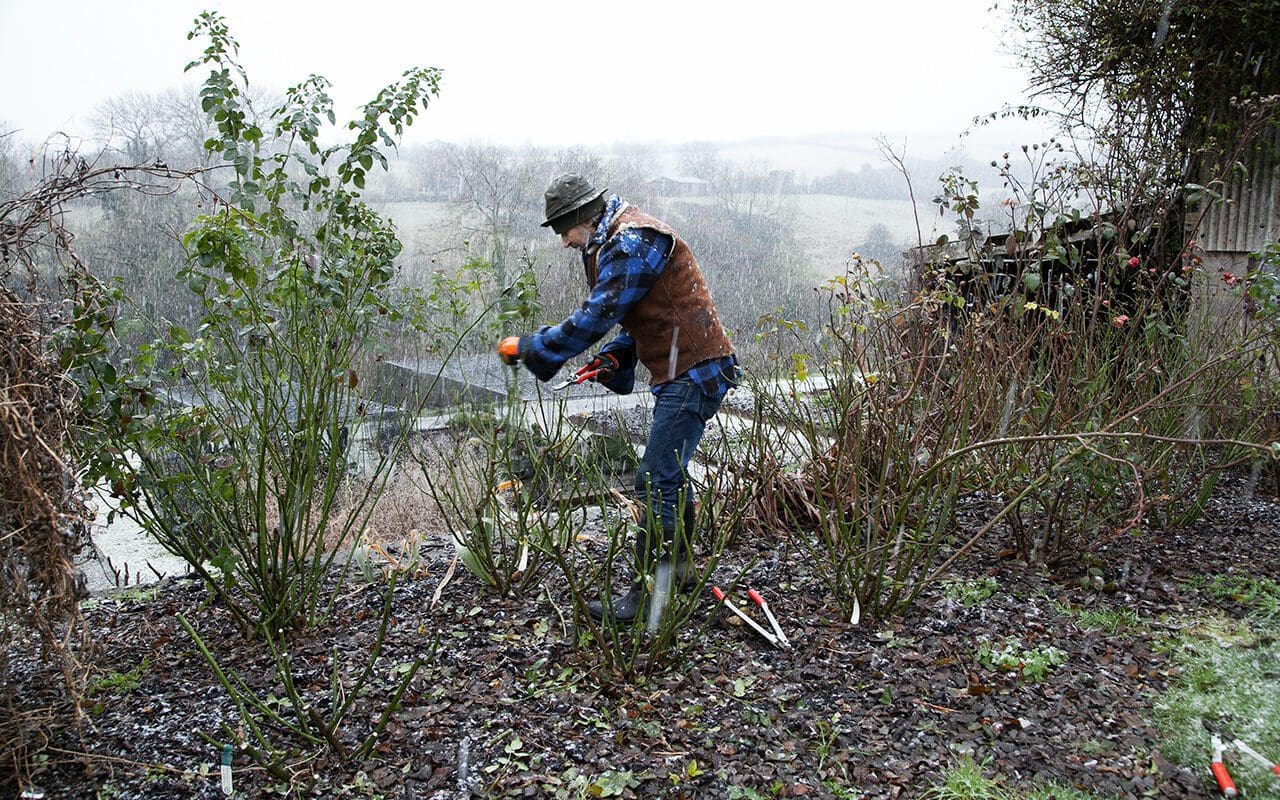
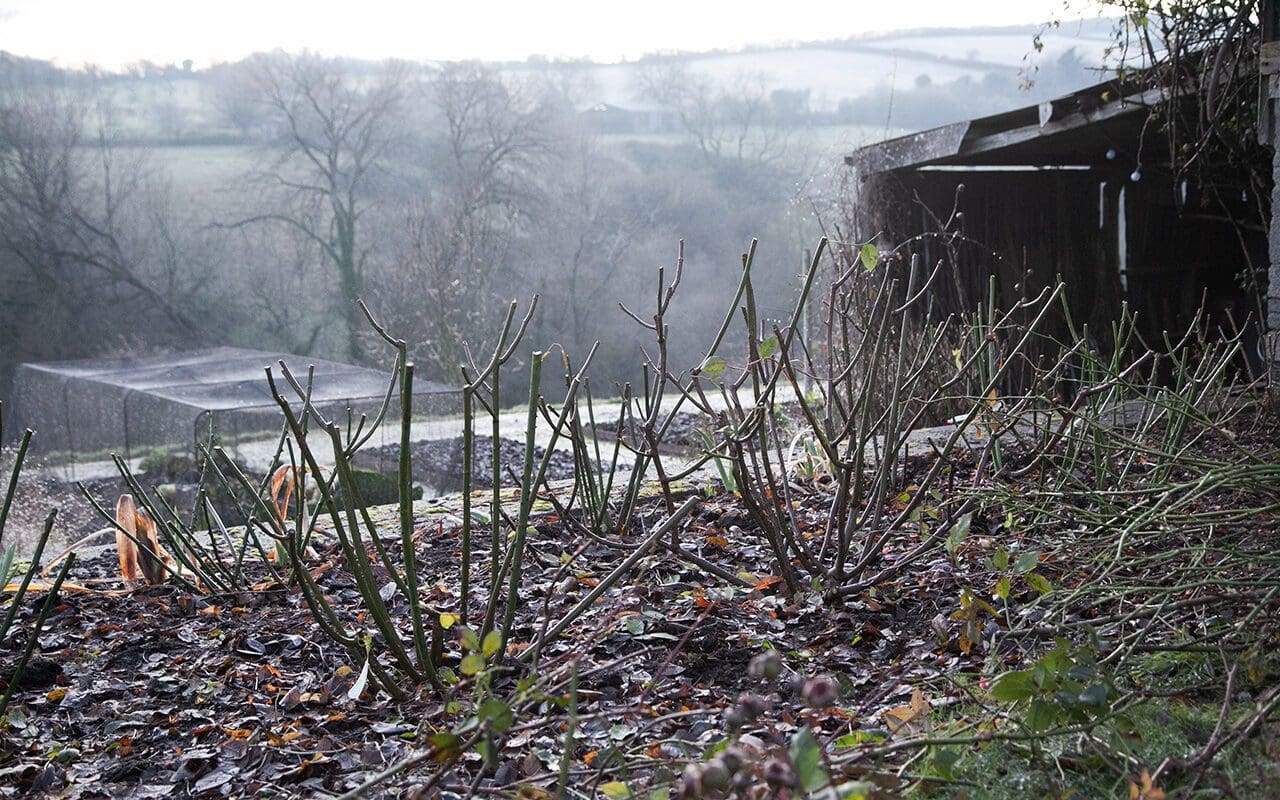
The winter work takes us out into the landscape with tree planting and hedge work and this is a good place to be to retain a clear overview and look back upon the garden. This year, with the help of John, who’s been helping us in the garden since April, we cleared the banks under the hazel at the top of the ditch where the snowdrops were already beginning to nose through the ground in December. They seem to appear earlier every year and I’d made plans to fell a mature hazel that we’d allowed to grow out from a previously broken hedge. There are just a handful of established hazel on the land, but the sixty or so youngsters I’ve planted to make a new coppice should be ready for harvesting by the time we have coppiced the elders.
Hazel responds well to coppicing on an eight to ten year cycle, sending up a fleet of fine young rods that thicken enough to harvest for wood and poles and branch at their reach to make a delicate weave for pea sticks. Wood cut in the first part of the winter retains a pliability that it loses the later it is cut, so the trigger of the snowdrops was useful in setting the winter work into motion in the last fortnight of December.
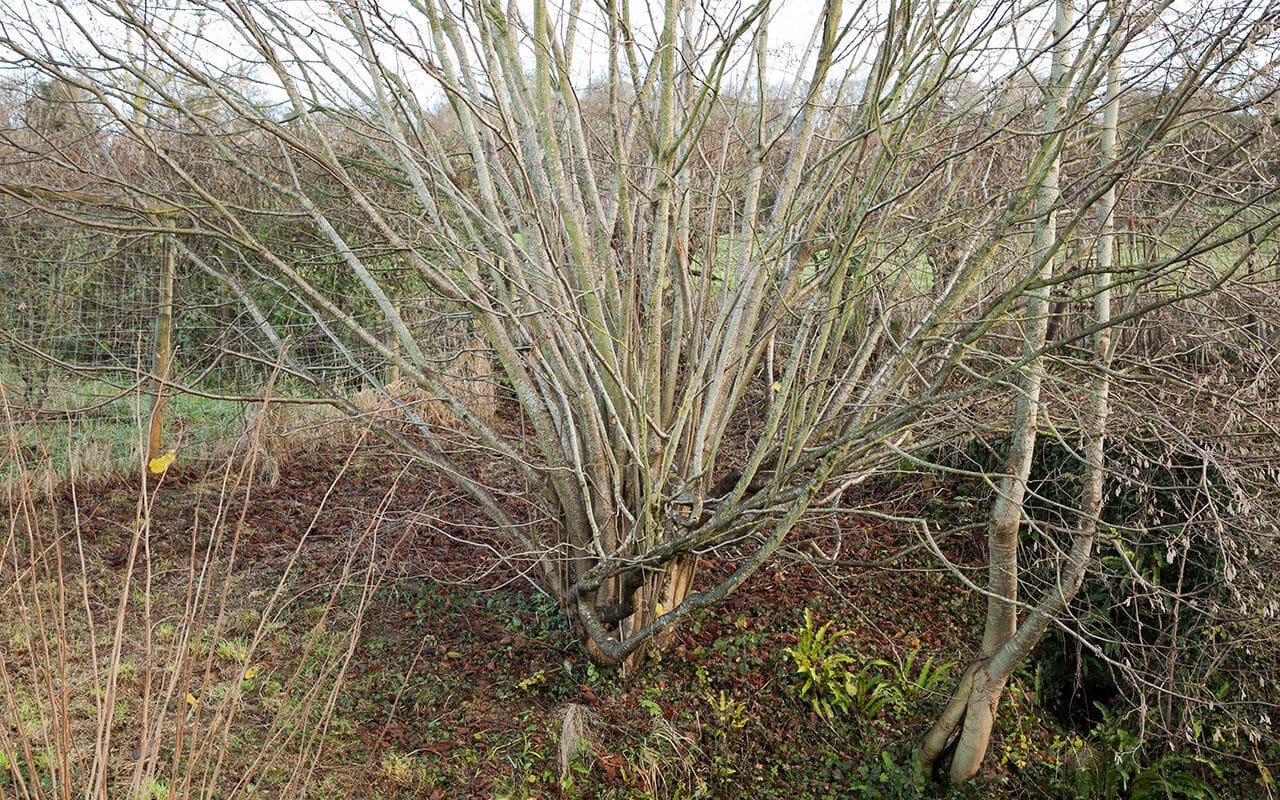
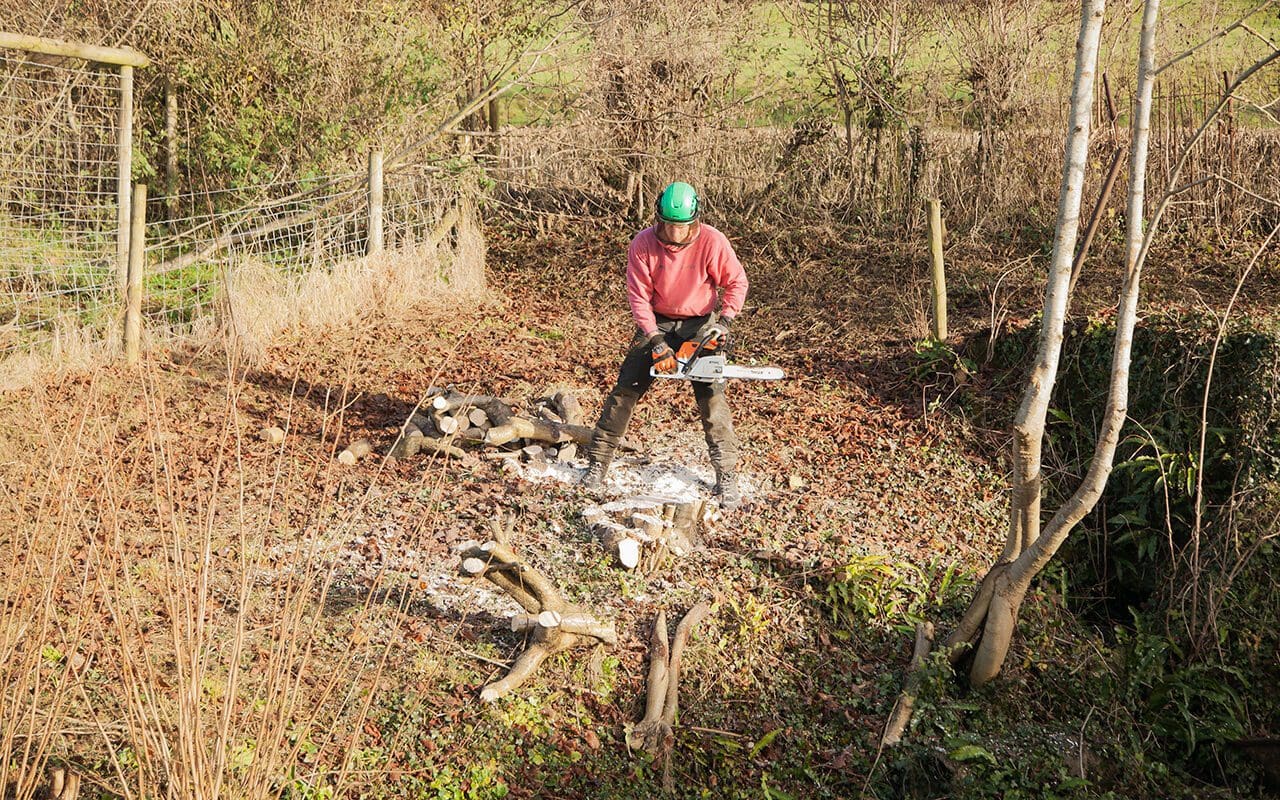

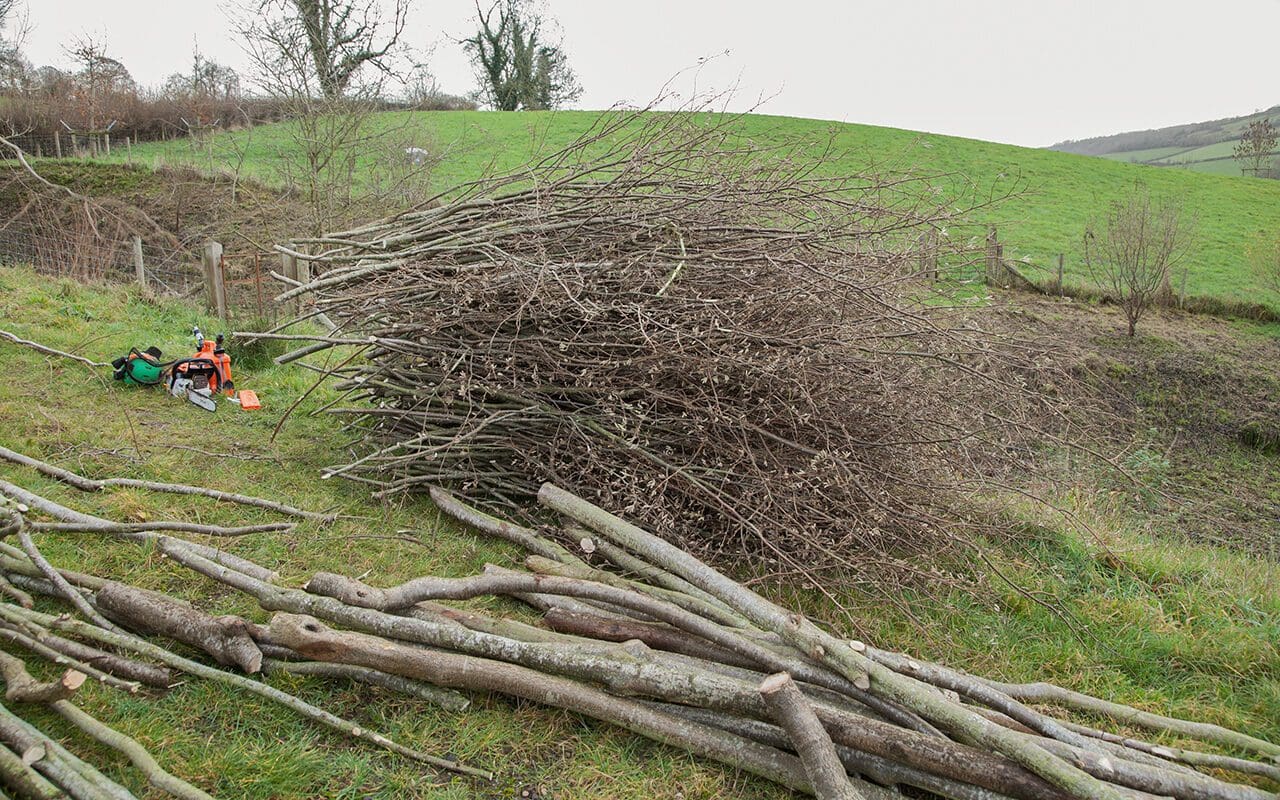
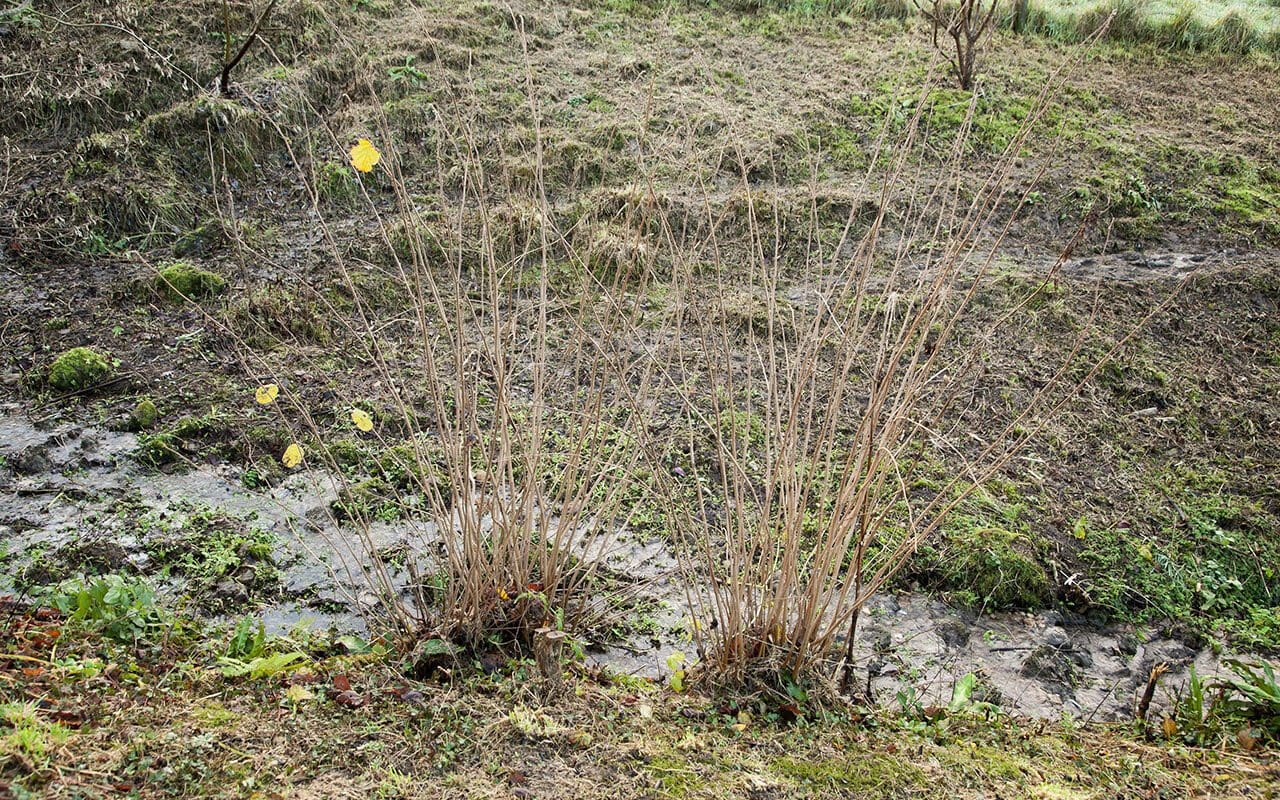
The old coppices I grew up with on the South Downs were well worked land and some of the oldest trees were possibly as much as a thousand years old with the middles of their ancient stools rotted away and the original plant sometimes broken into a family. Coppicing prolongs the life of a tree that responds well to it. Indeed, look at an old hazel that has been left unmanaged and you will often see its limbs leaning like nine pins and snapping at the stump. New growth regenerates from the wound, so management through coppicing simply takes advantage of this nature. The intervention of rotation improves the diversity in the wood, the pool of new light after the fell triggering the ephemerals like foxgloves which by nature live in the halfway place between the wood and the light at the margins.
Here on our banks beneath this recently felled hazel where we have been spreading the primroses about and planting wild daffodils, I expect to see a change these next couple of years. More speedwell, the bulbs basking in spring sunshine to feed their reserves and a proliferation of primrose seedlings that will take this opportunity to extend their reach whilst the going is good. It will not take long – two to three years for the hazel to close over again – and these newly established plants will begin a quieter time in the shadow.
We grade the cuttings, taking the wood for the burner and sectioning the rods for bean poles and the twiggery for pea sticks. The brash is bundled for faggots and a loose weave of unwanted branches is thrown back over the stumps to prevent deer grazing the new shoots in their first important year of ascending upwardly out of harm’s way. It is a process that we are happy to initiate and be part of as the year turns. One of renewal and hope and usefulness. A fine way to start a year that will not be without its challenges.
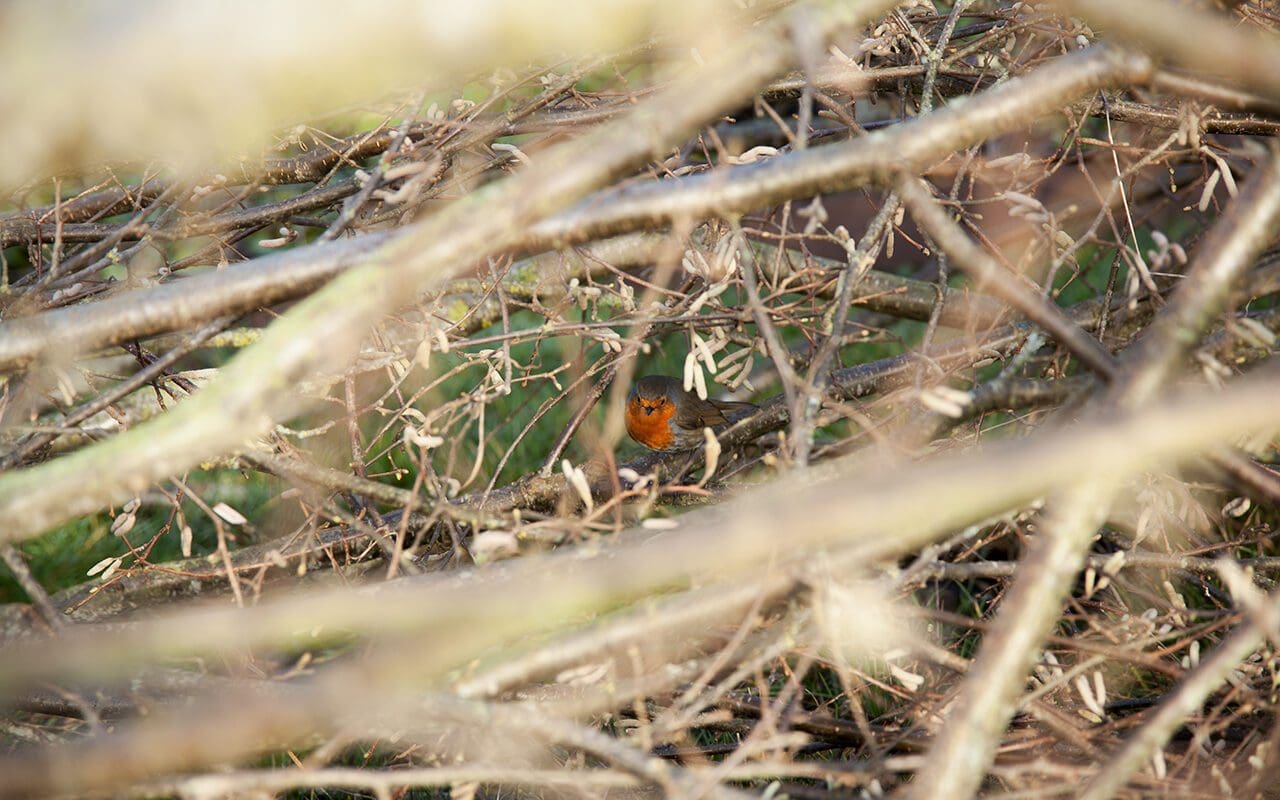
Words: Dan Pearson | Photographs: Huw Morgan
Published 9 January 2021
We are sorry but the page you are looking for does not exist. You could return to the homepage